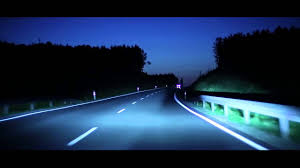Defensive Driving means using your headlights. Headlights are for seeing and BEING seen! Be sure to recognize the circumstances where lights are necessary for safety. The sobering statistic is that while only 25% of the miles we drive are at night, about 50% of the fatalities occur in the darkness—25,000 people each year. What can you do about it?
Visibility is poor if you are driving away from a setting (or rising) sun. Turn on your lights so oncoming traffic can see you. At dusk, it is difficult to see in that shadowy time after sunset before it gets completely dark. Turn on your lights, and be careful to watch for hazards, bicyclists, pedestrians, or animals. Also turn your lights on when you encounter fog, dust, heavy rain or snow. Reflected light from air-suspended particulates or precipitation can blind you, so use your low beams or properly installed fog lamps. Fog lamps are mounted low, underneath your line of sight, and they can help you see when regular headlamps cause difficulties. Without fog lamps, using low beams prevents light from being reflected back into your eyes much the same way.
If visibility is so reduced you cannot drive, pull off right as far as possible, stop, and turn OFF all lights—no 4-way flashers, no brake lights, no “parking” or marker lights. Why? Reduced depth perception caused by poor visibility and reflected light from particulate matter in the air may result in another driver following you, thinking you are still driving on the road. Investigations of major pile-up crashes suggest you are safer being invisible, as long as you can get off the road and out of the way. We realize this advice may be contrary to common thinking, but your greatest risk is that posed by drivers behind you who fail to slow—and the results are commonly fatal.
There are Defensive Driving situations where you want to grab the other driver’s attention. Turning on your headlights can be the most effective way to do this. On two-lane roads for example, there’s potential for head-on conflicts with other passing vehicles. Turn on your headlights, and you make it almost impossible for the oncoming vehicle NOT to see you.
Defensive Driving experts say at night, headlights are a given, but take a look at their limitations. The common practice of most drivers is to dim their headlamps when approaching within about 1,000 feet of an oncoming vehicle. Inside that range, it is uncomfortable for oncoming drivers and they will “remind” you to dim. Average high beam headlight range is about 350 feet, but on low beam only 160 feet. If you are traveling at 60 mph, you are covering about 90 feet per second. The average attentive person’s reaction time is .75 to 1.50 seconds. A person’s reaction distance at 60 mph would be somewhere between 67.5 and 135 feet; add braking distance to that and the total is over 300 feet. Put this all together, and on low beams, if something is in your path anywhere within up to 300 feet (the length of a football field), you can’t stop in time to miss it. If you cannot steer around it, you’re doomed; this is called “out-driving your headlights.”
Defensive Driving experts say the maximum safe speed for dark roadways at night is 35 or 40 mph! You can increase your night vision by purchasing a vehicle with brighter halogen or the still newer High Intensity Discharge headlights, or convert your older tungsten lamps to these newer, brighter ones. Make sure your headlamps are CLEAN—dirty lenses can reduce your lighting effectiveness by 50%! Use your brights as much as possible, but be courteous about it. Refrain from smoking at night—tobacco products contain substances that decrease your ability to see in the dark! Slow down considerably; the closer you are to that maximum safe speed, the less likely you will get into trouble. As we age, glare recovery becomes more of a problem, and some of the newer, brighter headlamps may cause increased difficulties in this regard. If you encounter oncoming headlights that are too bright, look to the right and align your vehicle with the “fog line,” while keeping an eye on the approaching vehicle out of the left corner of your field of vision. If you do get a ticket take our defensive driving class. http://www.2passdd.com
